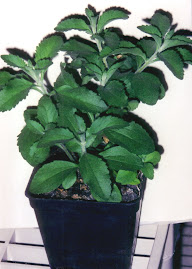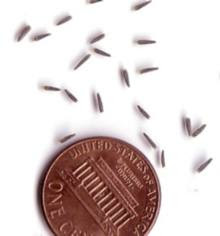The following is from
Growing and Using Stevia: The Sweet Leaf from Garden to Table with 35 Recipes.
Contents
Acknowledgements
List of Figures
Introduction
1. About the Stevia Plant
Plant Description
Day Length
Stevia in the Wild
2. Outdoor Soil and Culture
Compost
Fertilization
Raised Beds
Transplanting
Plant Care
3. Houseplants
Overwintering Outdoor Plants
Watering Houseplants
Potting up Houseplants
Fertilizing Houseplants
Lighting for Houseplants
Houseplants in the Spring
4. Propagation by Cuttings
Making Cuttings
Caring for Cuttings
Outdoor Propagation from Cuttings
5. Propagation from Seed
Seed Storage
Shopping List for Seed Starting
Directions for Seed Starting
6. Harvest and Storage
Drying Leaves
Storing Dried Leaves
7. Processing Stevia Leaves
Stevia Leaf Water Extract
Green Stevia Powder
8. Stevia in the Kitchen
Green Stevia Powder
Whole Dried Leaves
Liquid Stevia Extract
Stevia Extract Powder
9. Recipes
Simple Stevia Tea
Hot Tea, Green
Blueberry Grape Syrup
Puffy Oven Pancakes
Spiced Oat, Nut, and Fruit Granola
Gluten-Free Granola
Breakfast Oatmeal
Cinnamon Apple Oatmeal
Breakfast Sausage
Vanilla Nut ‘Ice Cream’
Orange Stevia Soda
Chocolate Milk Shake
Peach Smoothie
Strawberry Soup
Strawberry Smoothie
Chocolate Chip Cookies
Lime Pie
Rhubarb Strawberry Pie
Blueberry Pie
Carob Silk Pie
Coconut Whipped Cream
Lemon Chiffon Topping
Baked Custard
Pumpkin Custard
Grape Kiwi Salad
Pineapple Berry Gelatin
Sweet ‘n Spicy Meatballs
Savory Spaghetti Sauce
Special Garlic Toast
Herb Dumplings for Soup or Stew
Salt-Free Herbal Seasoning
Creamy Herb Salad Dressing
Sunflower Oat Rolls
Pumpkin Muffins
Rice Tomato Soup
Appendix: Stevia Sources and Resources
General Index
Recipe Index
Figures (photos in the book)0-1. Branched Stevia sprig
0-2. Stevia plant sprig
0-3. Stevia Leaf
0-4. Stevia blossoms
2-1. Raised growing beds
2-2. Young plant ready to transplant
2-3. Raised beds with Stevia plants
2-4. Raised bed with shade cover
2-5. Mulched plants with drip hose
2-6. Pruned stevia plant
2-7. Horizontal stem with vertical side branches
2-8. Mature Stevia plant
3-1. Large potted plant
3-2. Newly dug plants
3-3. Young houseplant
3-4. Overwintering plants indoors
3-5. Potted plant in the spring
4-1. Stem cutting
4-2. Newly planted cuttings
4-3. Rooted cuttings
5-1. Stevia seeds with penny
5-2. Recycled clamshell fl at
5-3. Newly planted cell packs
5-4. Young seedlings
5-5. Cell packs under fl uorescent light
5-6. Young Stevia plant from seed
5-7. Stevia seedlings in cell packs
6-1. Sprig with blossom buds
6-2. Dried leaves on stems
6-3. Drying Stevia leaves on a rack
8-1. Dried Stevia leaves
(continued below)
Acknowledgements
The authors would like thank their mother, Bertha Goettemoeller. She generously assisted in developing many of the recipes in this book. Thanks also to other family members who helped in many ways, especially as taste testers!
The late Dr. Alejandro Ching deserves a special expression of gratitude. As a professor of plant science at Northwest Missouri State University, he mentored Jeffrey, introducing him to stevia and other fascinating plants. He was always energetic and full of enthusiasm, especially about his faith and about plants that could help farmers and consumers. In 1998, Dr. Ching gave Jeffrey the chance to conduct an undergraduate research project, Seed germination in Stevia rebaudiana.
DisclaimerGrowing and Using Stevia is written for informational purposes only. It is not intended to diagnose, treat, cure, prescribe, or prevent any medical condition or replace the advice of a licensed health practitioner.
Growing and Using Stevia is not intended to provide all information on the subject matter covered. While every effort has been made to assure the accuracy of this book, there may be mistakes in content and typography. The authors and publisher assume no responsibility or liability with respect to any alleged or real damage caused, directly or indirectly, by information contained in this book. Inclusion of company names, contact information, web sites, product names, and other resources do not represent endorsements by the authors or publisher.
###
 Welcome to a sneak preview of Growing and using Stevia: The Sweet Leaf from Garden to Table with 35 Recipes, your complete guide to growing, harvesting, processing, and using stevia at home. Order your copy through online vendors such as:
Welcome to a sneak preview of Growing and using Stevia: The Sweet Leaf from Garden to Table with 35 Recipes, your complete guide to growing, harvesting, processing, and using stevia at home. Order your copy through online vendors such as:




